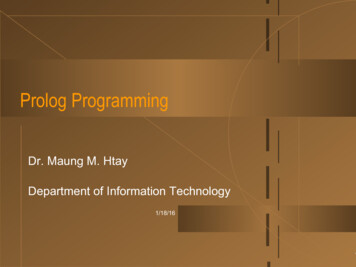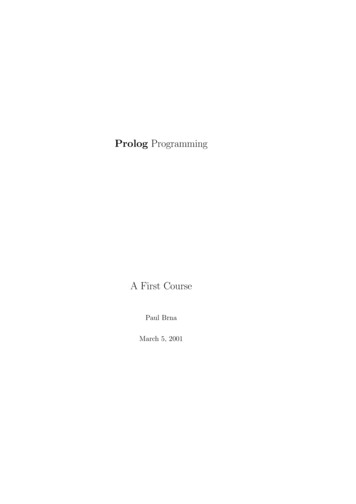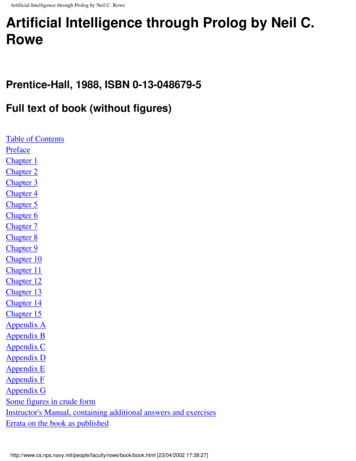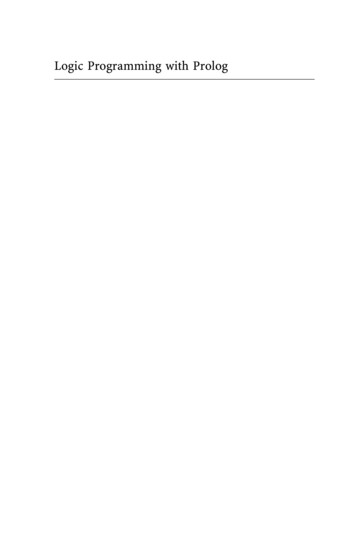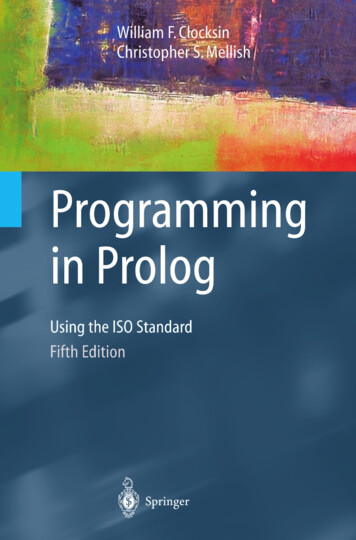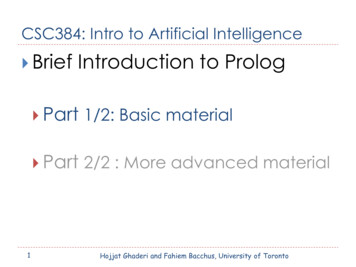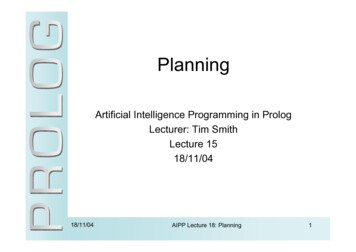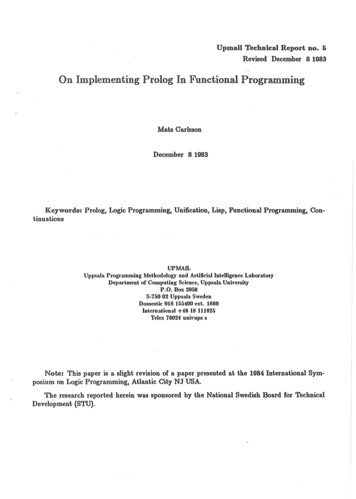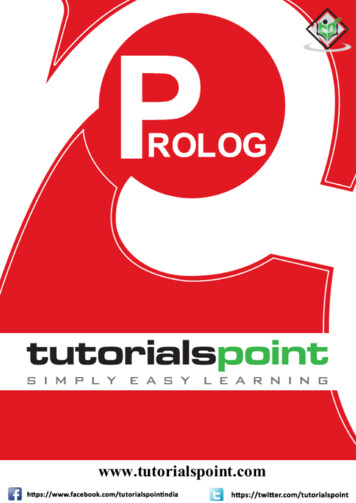
Transcription
Prologi
PrologAbout the TutorialProlog or PROgramming in LOGics is a logical and declarative programming language. Itis one major example of the fourth generation language that supports the declarativeprogramming paradigm. This is particularly suitable for programs that involve symbolicor non-numeric computation.AudienceThis reference has been prepared for the beginners to help them understand the basics ofprolog.PrerequisitesFor this tutorial, it is assumed that the reader has a prior knowledge in coding.Copyright & Disclaimer Copyright 2020 by Tutorials Point (I) Pvt. Ltd.All the content and graphics published in this e-book are the property of Tutorials Point (I)Pvt. Ltd. The user of this e-book is prohibited to reuse, retain, copy, distribute or republishany contents or a part of contents of this e-book in any manner without written consentof the publisher.We strive to update the contents of our website and tutorials as timely and as precisely aspossible, however, the contents may contain inaccuracies or errors. Tutorials Point (I) Pvt.Ltd. provides no guarantee regarding the accuracy, timeliness or completeness of ourwebsite or its contents including this tutorial. If you discover any errors on our website orin this tutorial, please notify us at contact@tutorialspoint.comii
PrologTable of ContentsAbout the Tutorial . iiAudience . iiPrerequisites . iiCopyright & Disclaimer . iiTable of Contents . iii1.Prolog ― Introduction . 1Logic and Functional Programming . 1What is Prolog? . 3History of Prolog . 3Some Applications of Prolog. 32.Prolog — Environment Setup . 5Prolog Version . 5Official Website . 5Direct Download Link . 5Installation Guide . 53.Prolog — Hello World . 10Hello World Program . 104.Prolog — Basics . 13Facts. 13Rules . 14Queries . 15Knowledge Base in Logic Programming . 155.Prolog — Relations . 20Relations in Prolog . 20Family Relationship in Prolog . 21Recursion in Family Relationship . 30iii
Prolog6.Prolog — Data Objects . 35Atoms and Variables . 36Anonymous Variables in Prolog . 377.Prolog — Operators . 39Comparison Operators . 39Arithmetic Operators in Prolog . 408.Prolog — Loop & Decision Making . 42Loops . 42Decision Making . 459.Prolog — Conjunctions & Disjunctions . 47Conjunction . 47Disjunction . 4710. Prolog — Lists . 49Representation of Lists . 49Basic Operations on Lists . 49Membership Operation . 50Length Calculation . 51Concatenation . 52Delete from List . 53Append into List. 54Insert into List . 55Repositioning operations of list items . 56Permutation Operation . 56Reverse Operation . 59Shift Operation . 59Order Operation . 60Set operations on lists . 61Subset Finding Operation . 61iv
PrologUnion Operation . 63Intersection Operation . 64Misc Operations on Lists . 65Even and Odd Length Operation . 65Divide List Operation . 66Max Item Operation . 68List Sum Operation . 69Merge Sort on a List . 7011. Prolog — Recursion and Structures . 72Recursion . 72Structures . 73Matching in Prolog . 74Binary Trees . 7412. Prolog — Backtracking . 76How Backtracking works? . 76Preventing Backtracking . 79Negation as Failure . 8213. Prolog — Different and Not . 85Not Relation in Prolog . 8714. Prolog — Inputs and Outputs . 88Handling input and output . 88Reading/Writing Files . 90Processing files of terms . 92Manipulating characters. 93Constructing Atoms . 95Decomposing Atoms. 95The consult in Prolog . 9615. Prolog — Built-In Predicates . 98v
PrologThe var(X) Predicate . 98The novar(X) Predicate . 99The atom(X) Predicate . 99The number(X) Predicate . 100The integer(X) Predicate . 100The float(X) Predicate . 100The atomic(X) Predicate . 101The compound(X) Predicate . 101The ground(X) Predicate . 102Decomposing Structures . 102The functor(T,F,N) Predicate . 102The arg(N,Term,A) Predicate . 103The ./2 Predicate . 103Collecting All Solutions . 104Findall/3, Setof/3 and Bagof/3 . 105The bagof/3 Predicate . 108Mathematical Predicates. 10916. Prolog — Tree Data Structure (Case Study) . 112More on Tree Data Structure . 115Advances in Tree Data Structures . 117PROLOG — EXAMPLES . 12117. Prolog ― Basic Programs . 122Max and Min of two numbers . 122Resistance and Resistive Circuits . 123Horizontal and Vertical Line Segments . 12518. Prolog — Examples of Cuts . 12719. Prolog — Towers of Hanoi Problem . 130vi
Prolog20. Prolog — Linked Lists . 13221. Prolog — Monkey and Banana Problem . 134vii
1. Prolog ― IntroductionPrologProlog as the name itself suggests, is the short form of LOGical PROgramming. It is alogical and declarative programming language. Before diving deep into the concepts ofProlog, let us first understand what exactly logical programming is.Logic Programming is one of the Computer Programming Paradigm, in which the programstatements express the facts and rules about different problems within a system of formallogic. Here, the rules are written in the form of logical clauses, where head and body arepresent. For example, H is head and B1, B2, B3 are the elements of the body. Now if westate that “H is true, when B1, B2, B3 all are true”, this is a rule. On the other hand, factsare like the rules, but without any body. So, an example of fact is “H is true”.Some logic programming languages like Datalog or ASP (Answer Set Programming) areknown as purely declarative languages. These languages allow statements about what theprogram should accomplish. There is no such step-by-step instruction on how to performthe task. However, other languages like Prolog, have declarative and also imperativeproperties. This may also include procedural statements like “To solve the problem H,perform B1, B2 and B3”.Some logic programming languages are given below: ALF (algebraic logic functional programming language). ASP (Answer Set Programming) CycL Datalog FuzzyCLIPS Janus Parlog Prolog Prolog ROOPLogic and Functional ProgrammingWe will discuss about the differences between Logic programming and the traditionalfunctional programming languages. We can illustrate these two using the below diagram:1
PrologFrom this illustration, we can see that in Functional Programming, we have to define theprocedures, and the rule how the procedures work. These procedures work step by stepto solve one specific problem based on the algorithm. On the other hand, for the LogicProgramming, we will provide knowledge base. Using this knowledge base, the machinecan find answers to the given questions, which is totally different from functionalprogramming.In functional programming, we have to mention how one problem can be solved, but inlogic programming we have to specify for which problem we actually want the solution.Then the logic programming automatically finds a suitable solution that will help us solvethat specific problem.Now let us see some more differences below:Functional ProgrammingLogic ProgrammingFunctional Programming follows the VonNeumann Architecture, or uses thesequential steps.Logic Programming uses abstract model,ordealswithobjectsandtheirrelationships.The syntax is actually the sequence ofstatements like (a, s, I).The syntax is basically the logic formulae(Horn Clauses).The computation takes part by executingthe statements sequentially.It computes by deducting the clauses.Logic and controls are mixed together.Logics and controls can be separated.2
PrologWhat is Prolog?Prolog or PROgramming in LOGics is a logical and declarative programming language. Itis one major example of the fourth generation language that supports the declarativeprogramming paradigm. This is particularly suitable for programs that involve symbolicor non-numeric computation. This is the main reason to use Prolog as the programminglanguage in Artificial Intelligence, where symbol manipulation and inferencemanipulation are the fundamental tasks.In Prolog, we need not mention the way how one problem can be solved, we just need tomention what the problem is, so that Prolog automatically solves it. However, in Prologwe are supposed to give clues as the solution method.Prolog language basically has three different elements:Facts: The fact is predicate that is true, for example, if we say, “Tom is the son of Jack”,then this is a fact.Rules: Rules are extinctions of facts that contain conditional clauses. To satisfy a rulethese conditions should be met. For example, if we define a rule as:grandfather(X, Y) :- father(X, Z), parent(Z, Y)This implies that for X to be the grandfather of Y, Z should be a parent of Y and X shouldbe father of Z.Questions: And to run a prolog program, we need some questions, and those questionscan be answered by the given facts and rules.History of PrologThe heritage of prolog includes the research on theorem provers and some otherautomated deduction system that were developed in 1960s and 1970s. The Inferencemechanism of the Prolog is based on Robinson’s Resolution Principle, that was proposedin 1965, and Answer extracting mechanism by Green (1968). These ideas came togetherforcefully with the advent of linear resolution procedures.The explicit goal-directed linear resolution procedures, gave impetus to the developmentof a general purpose logic programming system. The first Prolog was the MarseilleProlog based on the work by Colmerauer in the year 1970. The manual of this MarseilleProlog interpreter (Roussel, 1975) was the first detailed description of the Prolog language.Prolog is also considered as a fourth generation programming language supporting thedeclarative programming paradigm. The well-known Japanese Fifth-Generation ComputerProject, that was announced in 1981, adopted Prolog as a development language, andthereby grabbed considerable attention on the language and its capabilities.Some Applications of PrologProlog is used in various domains. It plays a vital role in automation system. Following aresome other important fields where Prolog is used: Intelligent Database Retrieval Natural Language Understanding3
Prolog Specification Language Machine Learning Robot Planning Automation System Problem Solving4
2. Prolog — Environment SetupPrologIn this chapter, we will discuss how to install Prolog in our system.Prolog VersionIn this tutorial, we are using GNU Prolog, Version: 1.4.5Official WebsiteThis is the official GNU Prolog website where we can see all the necessary details aboutGNU Prolog, and also get the download link.http://www.gprolog.org/Direct Download LinkGiven below are the direct download links of GNU Prolog for Windows. For other operatingsystems like Mac or Linux, you can get the download links by visiting the official website(Link is given mingw-x86.exe (32 Bit mingw-x64.exe (64 Bit System)Installation Guide Download the exe file and run it. You will see the window as shown below, then click on next:5
PrologSelect proper directory where you want to install the software, otherwise let it be installedon the default directory. Then click on next.You will get the below screen, simply go to next.6
PrologYou can verify the below screen, and check/uncheck appropriate boxes, otherwise youcan leave it as default. Then click on next.In the next step, you will see the below screen, then click on Install.7
PrologThen wait for the installation process to finish.Finally click on Finish to start GNU Prolog.8
PrologThe GNU prolog is installed successfully as shown below:9
3. Prolog — Hello WorldPrologIn the previous section, we have seen how to install GNU Prolog. Now, we will see how towrite a simple Hello World program in our Prolog environment.Hello World ProgramAfter running the GNU prolog, we can write hello world program directly from the console.To do so, we have to write the command as follows:write('Hello World').Note: After each line, you have to use one period (.) symbol to show that the line hasended.The corresponding output will be as shown below:Now let us see how to run the Prolog script file (extension is *.pl) into the Prolog console.Before running *.pl file, we must store the file into the directory where the GNU prologconsole is pointing, otherwise just change the directory by the following steps:Step 1: From the prolog console, go to File Change Dir, then click on that menu.Step 2: Select the proper folder and press OK.10
PrologNow we can see in the prolog console, it shows that we have successfully changed thedirectory.Step 3: Now create one file (extension is *.pl) and write the code as follows:main :- write('This is sample Prolog program'),write(' This program is written into hello world.pl file').Now let’s run the code. To run it, we have to write the file name as follows:[hello world]The output is as follows:11
Prolog12
4. Prolog — BasicsPrologIn this chapter, we will gain some basic knowledge about Prolog. So we will move on tothe first step of our Prolog Programming.The different topics that will be covered in this chapter are:Knowledge Base: This is one of the fundamental parts of Logic Programming. We willsee in detail about the Knowledge Base, and how it helps in logic programming.Facts, Rules and Queries: These are the building blocks of logic programming. We willget some detailed knowledge about facts and rules, and also see some kind of queries thatwill be used in logic programming.Here, we will discuss about the essential building blocks of logic programming. Thesebuilding blocks are Facts, Rules and the Queries.FactsWe can define fact as an explicit relationship between objects, and properties these objectsmight have. So facts are unconditionally true in nature. Suppose we have some facts asgiven below: Tom is a cat Kunal loves to eat Pasta Hair is black Nawaz loves to play games Pratyusha is lazy.So these are some facts, that are unconditionally true. These are actually statements, thatwe have to consider as true.Following are some guidelines to write facts: Names of properties/relationships begin with lower case letters. The relationship name appears as the first term. Objects appear as comma-separated arguments within parentheses. A period "." must end a fact. Objects also begin with lower case letters. They also can begin with digits (like1234), and can be strings of characters enclosed in quotes e.g. color(penink, ‘red’). phoneno(agnibha, 1122334455). is also called a predicate or clause.SyntaxThe syntax for facts is as follows:13
Prologrelation(object1,object2.).ExampleFollowing is an example of the above concept:cat(tom).loves to eat(kunal,pasta).of color(hair,black).loves to play games(nawaz).lazy(pratyusha).RulesWe can define rule as an implicit relationship between objects. So facts are conditionallytrue. So when one associated condition is true, then the predicate is also true. Supposewe have some rules as given below: Lili is happy if she dances. Tom is hungry if he is searching for food. Jack and Bili are friends if both of them love to play cricket. Ryan will go to play if school is closed, and he is free.So these are some rules that are conditionally true, so when the right hand side is true,then the left hand side is also true.Here the symbol ( :- ) will be pronounced as “If”, or “is implied by”. This is also known asneck symbol, the LHS of this symbol is called the Head, and right hand side is called Body.Here we can use comma (,) which is known as conjunction, and we can also use semicolon,that is known as disjunction.Syntaxrule name(object1, object2, .) :- fact/rule(object1, object2, .)Suppose a clause is like :P :- Q;R.This can also be written asP :- Q.P :- R.If one clause is like :P :- Q,R;S,T,U.Is understood as14
PrologP :- (Q,R);(S,T,U).Or can also be written as:P :- Q,R.P :- S,T,U.Examplehappy(lili) :- dances(lili).hungry(tom) :- search for food(tom).fr
This is the main reason to use Prolog as the programming language in Artificial Intelligence, where symbol manipulation and inference manipulation are the fundamental tasks. In Prolog, we need not mention the way how one problem can be solved, we just need to mention what the problem is, so that Prolog aut
